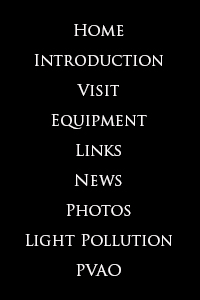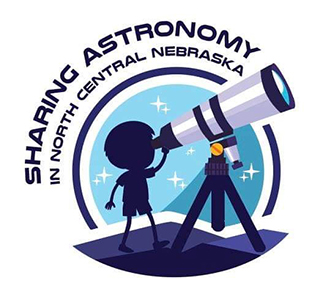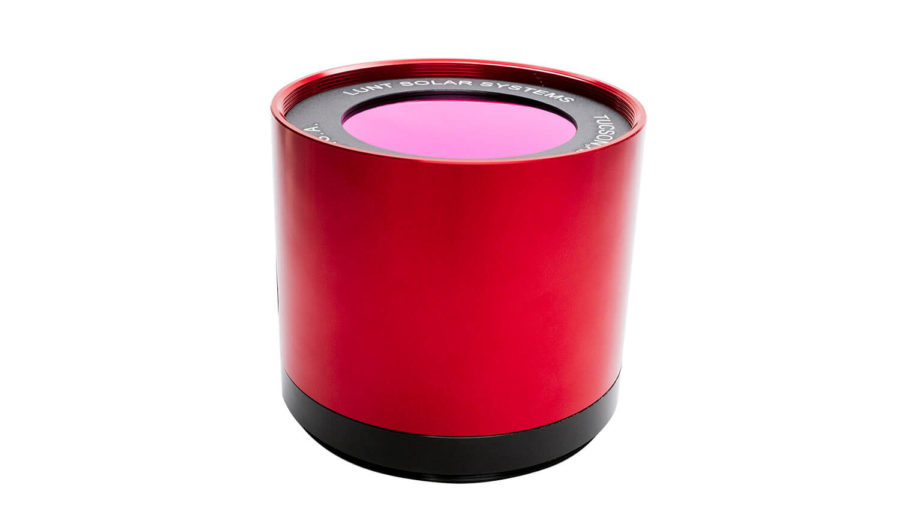
O'Neill Nebraska
Director - Mark Urwiller
Staff: Leon Thompson, Lianna Murphy
Equipment Page

For those of you wanting to know the "nuts and bolts" of the observatory's equipment - this page is for you.
Here goes:The main instrument is a 17.5" fork mounted equatorial Newtonian reflector driven with ServoCAT GOTO drive designed and engineered by Jay Rasmussen (deceased) of Kenesaw Nebraska. To be rid of tangled wires in the dark - wireless control has been added.
The truss shroud was created by Heather Teeter of Shrouds By Heather - http://www.scopeshrouds.com/
The Right Ascension gear is a 12" Mathis 266 tooth anodized aluminum gear purchased in the early 80's.
The Declination gear was manufactured by www.gototelescopes.com and is a 12" 360 tooth anodized aluminum gear.
The mirror was manufactured by the former Coulter Optics and is supported by a Novak 18 pt cell - previously owned by Charles Morris at the JPL in Pasadena California. Tested by Steve Swayze (deceased) of Portland Oregon in 2012, refigured, and re-coated with enhanced coatings by Spectrum Coatings of Deltona Florida.
The spider is custom made by Jay Rasmussen and the secondary mirror holder was created by Kenneth Novak - deceased.
The focuser is a Jim's Mobile EV-1nM 2" Crayford with motorized focus.
Finders include a University Optics (no longer in business) 11x80 mm with right angle amici prism or straight through option and a Telrad manufactured by my friend, now deceased, Steve Kufeldt in Southern California.
10,000 step digital encoder setting circles are employed along with SkyCommander database.
Televue Ethos eyepieces include 21mm, 13mm, 8mm and the 31mm (type 5 "grenade") Nagler. Older eyepieces include, among others, 4 older Televue Naglers 20mm type 2, 13 mm, 9 mm, and 7 mm.
Light pollution rejection filters include Lumicon Deep Sky and Ultra High Contrast - in 2" and 1.25" sizes and an OIII filter in 2" size. DGM NBP 2" filter
For photography I have a Lacerta MGEN3 autoguider which is used with a 60mm guidescope on the Orion Atlas mount listed or through the main observatory scope with an off-axis guider. This off-axis guider can be configured to accomodate Nikon and Pentax cameras as well as my Canon cameras. I also have an Orion StarShoot AutoGuider Imaging is now done by a Canon EOS R5 H alpha modified by Spencers Camera. Additional camera includes an unmodified Canon R7 to be modified when the Canon R7 MKII is released.
In addition to the large scope I also have a vintage 1972 Optical Craftsman 6" f10 (Sirius Model) German Equatorial Reflector with added clock drive and circles, a set of 10x70 Fujinon binoculars on a parallelogram suspension mount, and a 10" Meade dobsonian mounted reflector. Donated equipment includes a pair of Zhumell Tachyon 25x100 binoculars. An Orion Atlas 10" EQ-G Goto reflector and 6" Orion Skyquest XT6 dobsonian with "push-to" Intelliscope database upgrade. I have purchased a QHY Polemaster for quick polar alignment for the 10" mount to allow a nice platform for wide field and telephoto astrophotography.
Printed star charts include Skalnate Pleso, Sky Atlas 2000, and Uranametria 2000. Astronomical Software includes Megastar, Cartes du Ciel, Stellarium, Tri-Atlas, and the similar Deep Sky Hunter Atlas etc. There is also a respectable library of vintage astronomical texts/observers handbooks etc. The observatory has internet access. The main computer has a CRT monitor and SSD storage - so nothing will freeze up in the winter or reader arms on HDDs that won't warp in summer heat :) A laptop is also brought in.
The observatory has Thousand Oaks Optical filters for solar photography with a 500 mm lens and viewing through a 80mm Swarovski spotting scope.
The observatory has a Sky Quality Meter and is reporting sky darkness to Loss of the Night and Globe at Night.
I got tired of fighting dew and frost while trying to observe or take photographs and ordered another 12V distribution center from astrosystems.biz and 3 dew tapes from Astronomics.
New Equipment Acquired March 2024
May 5, 2023 I lost a good friend - Jay Rasmussen. His remarkable engineering and machining skills made most of the observatory and its equipment possible. I knew Jay had a nice telescope and other items. He was too busy to attend star parties and usually volunteered as a shooting range guide on the same night at PVAO meetings. Since Jay lived about 3 hours away from me, I didn't see his equipment much and didn't really know what he had. He usually drove up to the observatory to work or bring things fabricated for my scope in his shop. After Jay's passing, his wife asked me if anyone in the Platte Valley Astronomical Observers might be interested in buying his equipment. I looked at what he had and found he had astounding equipment! After thinking about it I decided I wanted it in rememberance of him. This equipment will take my astrophotography to a new level!
Unlike the other scopes in my observatory, Jay had a very nice refracting telescope! Refractors, if very high quality, offer some of the best images possible since, unlike reflectors (like mine), have no obstructions in the light path. Reflectors usually have 2 mirrors, one of which reflects the light to the eyepiece or camera. This "secondary" mirror obstructs a portion of the light path and causes diffraction. The net effect of this is that a high quality refractor can use higher magnifications if atmospheric conditions allow. OK, what constitutes a high quality refractor you say? The best refractors, certainly not available in department stores, are apochromatic (not achromatic). These scopes use the best quality "extended definition" glass or Flourite. Unlike cheap refractors, they use 3 or more lenses (besides the eyepiece) to bring all the colors of light that enter the scope to focus at once - avoiding color "fringing" The mount Jay had was also very nice! Here is the list of these I have that was his:
Televue NP127 refractor The IS version is linked. Jay's was purchased in 2004 and is in pristine condition. The newer version is optically identical,but the focuser was modified for better astrophotography application. The price linked for the scope is the OTA (Optical Tube Assembly) only! He basically purchased this package, but with a more expensive eyepiece! The finder is a Televue Starbeam. Eyepieces are Televue Naglers in 22, 12, 9, 5, and 3.5mm. I purchased a Stellervue 50mm guide scope to use for photography mounted by a Televue bracket.
The mount is a Losmandy G11 with Gemini 1 GoTo and tripod. Current models have the Gemini 2 GoTo. Jay purchased the illuminated polar finder, but I have purchased an adapter to use my Polemaster listed above. Jay also purchased these higher quality clutch knobs. There is also a StarGPS NX01 - the newer NX03 is linked. This unit sends the exact coordinates and time at the scopes location to the GoTo.
I have purchased a digital 12V power supply upscaled to 17V for higher torque, assorted wires for PC control, and new higher friction clutch disks from Michael Herman of Sunnyvale California. I also ordered a Baadar Solar film filter for the scope.
Other items from Jay - Fujinon 16 x 70mm binoculars with parallelogram suspension mount and tripod which he made. Astronomik 2" and 1.25" round filters in OIII, UHC and H-Beta versions - six in total. Jay also had a library of hardbound books and star charts - all in pristing condition - as well as all the documentation and receipts for all of the items. Lastly, Jay had several Nagler eyepieces which will be used with his telescope. I will always think of him when I use this equipment!
May and June 2024 - the observatory now has a 60mm Hydrogen alpha solar scope.
This scope is manufactured by Lunt Solar Systems in Arizona. H alpha telescopes allow viewing of the sun's chromosphere. The chromosphere is just above the photosphere - which is what we see. This scope will be able to see filaments, spicules, and prominances. The only time prominances can be seen without a telescope like this, is during a total solar eclipse! The scope has a B 1200 blocking filter. I also purchased a 2" solar (Hershel) wedge for high detail views of the photosphere. You can see what the scope looks like and the additional double stack filter below.
The focuser on this new telescope is motorized to allow fine focus for photography without vibrating the scope. The motorization unit is a ZWO EAF advanced set. Photographs are taken by a Player One Neptune-M mono camera. Capture, stacking, and sharpening software - all freeware - is utilized to process the images. I decided to purchase a Skywatcher SolarQuest which is lightweight and automatically finds the sun ands keeps it in the field of view. I use the scope for outreach and it keeps the sun centered for several people in a row. This setup is also used for short duration solar photography. You can see this mount in the video below:
For my birthday in June, I received a Nexus DSC Pro (with WiFi) for the main observatory telescope. "DSC" stands for digital setting circles and is a device which interprets signals from ecoders placed on each rotation axis of the telescope. This is matched with a database contained within the unit which allows the scope to find hundreds of thousands of objects in the sky. The scope was equipped with a Sky Commander unit listed above, but this had become outdated. This new unit has WiFi which allows wireless control from the observatory computer, which by the way is also updated. The new computer is based on a mini ATX motherboard design. It has a very small footprint and is very portable. It will be transported to and from the observatory to keep it clean.
The end of July 2024, I purchased a ZWO Seestar S50. This is a smart telescope designed for you to run from a smartphone. It's a great first telescope that points itself toward objects in the night sky, tracks them, and takes photos of them. Actually it will several images of the object and stack them - creating a final image that is saved to your smartphone and can be shared with others via email or social media. Its now what I recommend for a first telescope. It really does a lot for the price! I do have to add a couple of caveats. Although it's fun, it doesn't help you learn to find objects in the night sky - that takes more effort. It does take photos which will good enough for most people, but you can't print them much bigger than 4 x 6 inches. The camera is only 2 megapixels. Hopefully it will spark enough interest to encourage deeper understanding. See the video below.
Keep Looking Around!
Mark Urwiller - Web Page Administrator
Send comments to: mark.urwiller@tutanota.com
Home Introduction Visitation Dates Observatory Equipment Links
Observatory News Photos Light Pollution PVAO



